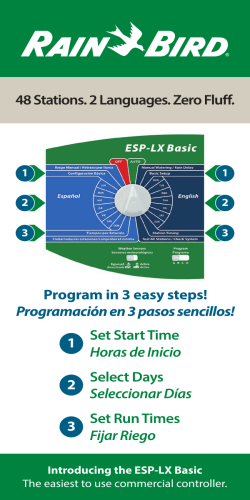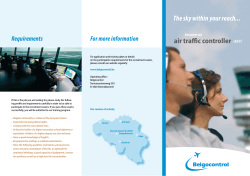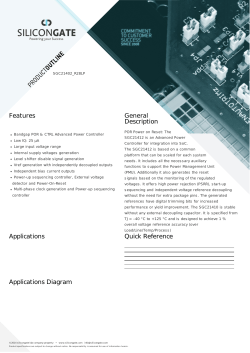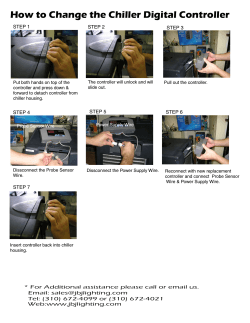
ORIGINAL ARTICLES Type-2 Fuzzy Logic PI
2564 Journal of Applied Sciences Research, 8(5): 2564-2574, 2012 ISSN 1819-544X This is a refereed journal and all articles are professionally screened and reviewed ORIGINAL ARTICLES Type-2 Fuzzy Logic PI (T2FLPI) Based DC Servomotor Control Haytham M. Fayek and I. Elamvazuthi Electrical and Electronic Engineering Department, Universiti Tecknologi PETRONAS, Malaysia ABSTRACT This paper presents the detailed design of Type-2 Fuzzy Logic PI controller to control the speed of a DC servomotor. The controller is explored extensively in terms of number, type of membership functions and judged in 3 different cases; which are unity step response, load disturbance and noise disturbance. The performance of the controller is measured in terms of parameters such as rise time, settling time, percent overshoot and integral absolute error. A comparative analysis with the conventional type-1fuzzy logic PI controller shows that overall, type-2 showed much improved results. This improvement is evident when it comes to handling of load disturbance and noise added to the system. Key words: Type-2 Fuzzy logic, Type-1 Fuzzy Logic, PI controller, DC servomotor Introduction There are two types of motors: DC motors, and AC motors. DC motors have better starting torque than AC motors. Servomotors use feedback controller to control the speed or the position, or both. Any motor can be used as a servomotor. Servomotors are used in various applications in industrial electronics and robotics that includes speed control as well as precision positioning. The basic continuous feedback control is PID controller. The PID controller exhibits good performance but is not adaptive enough (Oyas & Nordin, 2008). This is evident in a system when the load is changed or in a noisy system, where the original controller generally cannot maintain the design performance and thus should be re-designed for the new system conditions. Professor L.A. Zadeh presented the fuzzy sets in 1965, which have the ability to process data and information affected by unprobabilistic uncertainty. Intelligent Systems based on fuzzy logic are fundamental tools for nonlinear complex system modeling. Fuzzy sets are considered a generalization of the classic set theory. Type-1 Fuzzy sets and fuzzy logic are the basis for fuzzy systems, where their objective has been to model how the brain manipulates inexact information. Prof. Zadeh answered the questions doubting the ability of type-1 fuzzy logic of handling uncertainty by proposing the concept of type-2 fuzzy in 1975. Type-2 fuzzy sets are used for modeling uncertainty and imprecision in a better way. They are very useful in circumstances where it is difficult to determine an exact membership function for a fuzzy set; hence they are very effective for dealing with uncertainties. Type-2 fuzzy logic has found applications in various fields (H. C. Nejad, 2011). A good explanation about type-2 fuzzy logic is presented in this paper (J. M. Mendel & R. I. Bob John, 2002) Fuzzy Logic Control has demonstrated superiority over PID controllers in terms of: (Nalunat Khongkoom et al., 2000) Better noise rejection More flexible FLC use human knowledge, not accurate mathematical model Less sensitive to inertia Variation Better overall system performance This paper investigates the performance of a small and fast DC servomotor with Type-2 and Type-1 Fuzzy logic PI controllers. Simulations are executed to judge the performance of the servomotor with different number of membership functions and types of membership. Three different scenarios are simulated, which are unity step response, load disturbance to the servomotor and noise disturbance. The performance parameters are Rise time, Settling time, Percent overshoot, and Integral Absolute error. Control Techniques: PI Controller: PID controllers are very popular in industrial control applications due to their simple structures, low costs Corresponding Author: Haytham M. Fayek, Electrical and Electronics Department, Universiti Tecknologi PETRONAS, Malaysia. Email: [email protected] 2565 J. Appl. Sci. Res., 8(5): 2564-2574, 2012 and understandable control algorithms. Figure 1 shows the schematic model of a PID controller. In this paper, PI controller was selected, as it can be integrated easily with a fuzzy logic controller PI controller uses control signal u(t), which is a linear combination of error e(t), and its integral. (M. Mohammad Abadi et al., 2011) u(t) = Kpe(t) + KI ∫ e(t) dt u(t) = Kp (e(t) + (1) 1 ∫ e(t) dt) TI (2) Where, Kp = proportional gain, KI = integral gain, TI = integral time Fig. 1: PID Controller. PID controllers are usually tuned using hand tuning or Ziegler-Nichols methods to obtain the desired performance according to preset criteria. Type-1 Fuzzy Logic Controller: A fuzzy control system is a control system based on fuzzy logic, that is a mathematical system that evaluates analogue input values in terms of logical variables that take on continuous values between 0 and 1, in contrast to classical logic, which only has two distinct values; 0 or 1. Although genetic algorithms and neural networks may perform just as well as fuzzy logic in many cases, but fuzzy logic has the advantage that the solution to the problem can be generated in terms that human operators can understand, in a way to utilize their experience in the design of the controller. This makes it easier to automate tasks that are already successfully performed by humans. A fuzzy logic system is shown in Figure 2. Rules Crisp X Fuzzifier Input Crisp Output Fuzzy Inference Engine Fuzzy Input Sets Y Defuzzifier Fuzzy Output Sets Fig. 2: Type-1 Fuzzy Logic System. The input variables in a fuzzy control system are in general mapped into sets of membership functions, known as fuzzy sets. Fuzzification is the process of converting a crisp input value to a fuzzy value. The membership function is a graphical representation of the magnitude of partaking of each input. It assigns a weighting to each of the inputs that are processed, defines functional overlap between inputs, and eventually determines an output response. There are different memberships functions associated with each input and output response. Some features to note about membership functions are the number, type and overlap of the membership functions. The human knowledge is used to construct the fuzzy rules, which follow the following form: IF <Antecedent> THEN <Consequent> 2566 J. Appl. Sci. Res., 8(5): 2564-2574, 2012 The rules use the input membership values as weighting factors to determine their influence on the fuzzy output sets of the final output conclusion. Once the functions are inferred, scaled, and combined, they are defuzzified into a crisp output, which drives the system. Type-2 Fuzzy Logic Controller: Mendel and Liang introduced the Type-2 Fuzzy Logic Control System (T2FLCS) (E. Kayacan et al., 2010). Type-2 Fuzzy Logic Control Systems has a unique characteristic over the conventional type-1 that is the membership function itself became fuzzy-three-dimensional. T2FLCS allows the characterization of a type-2 fuzzy set with a superior membership function and an inferior membership function; these two functions can be represented each one by a type-1 fuzzy set membership function. The interval between these two functions represents the footprint of uncertainty (FOU). The superior membership function is denoted by Upper membership Function (UMF), while the inferior membership function is denoted by Lower Membership function (LMF). Interval type-2 membership function is shown in Figure 3 (I. Robandi, & B. Kharisma, 2009). Fig. 3: Type-2 Membership Function (I. Robandi, & B. Kharisma, 2009) The structure of a fuzzy logic type-2 system is shown in Figure 4. Fig. 4: Type-2 Fuzzy Logic System (Castillo et al., 2008) Fuzzy logic type-2 system includes 4 components (Castillo et al., 2008): Fuzzifier: Translates inputs (real values) to fuzzy values. Inference System: Applies a fuzzy reasoning mechanism to obtain a fuzzy output. Type Defuzzifier/Reducer: The defuzzifier translates one output to precise values; the type reducer transforms a Type-2 Fuzzy Set into a Type-1 Fuzzy Set. Knowledge Base: Contains a set of fuzzy rules, and a membership functions set known as the database. 2567 J. Appl. Sci. Res., 8(5): 2564-2574, 2012 Materials And Methods DC Servomotor: The motor chosen in this paper is a very small brushless DC servomotor used in the PCB industries based on an actual DC servomotor. It is a Faulhaber brushless DC servomotor (Series 1226012B), which is characterized by high speed, small inertia and high accuracy and precession (Ritz Faulhaber et al., 2011). The servomotor can be represented by the following transfer function: Ke W( s ) 2 V ( s ) J .L.s ( J .R L.B ).s ( K t .K e R.B ) (3) where, W = angular Speed (rad/s) V = armature voltage (V) R = armature resistance (Ω) = 5.3 Ω L = armature inductance (H) = 80 x 10-6 H J = rotor inertia (Kgm2) = 0.145 x 10-7 Kgm2 B = viscous friction coefficient (Nms/rad) = 7.8 x 10-8Nms/rad Ke = torque constant (Nm/A) = 4.09 x 10-3 Nm/A Kt = back emf constant (Vs/rad) = 4.09 x 10-3Vs/rad The motor model was constructed in Simulink as shown in Figure 5. The model has 2 inputs, which are the voltage and the load. It has 1 output, which is the speed of the servomotor. Fig. 5: DC Servomotor Model. Fuzzy Logic PI Controller: A fuzzy logic controller is usually combined with either a PI or PD controller in motor control applications. In this paper, PI controller was chosen, as it had better overall system performance. Moreover, PD fuzzy logic controller usually results in steady state error, as it lacks integral function in its control nature (M.A. Ahmad et al., 2010). The PI controller was tuned using the Simulink tuning block followed by hand tuning. The values for the PI controller were set to P = 0.002168 and I = 730.79. The overall system performance is displayed in Table 1. Table 1: PI controller Performance attributes. Performance Parameter Rise Time Settling Time Percent Overshoot IAE Attribute 0.0056 s 0.0288 s 11.65% 0.0044 The values of the tuned PI controller were used to compute the gains for the fuzzy logic PI controller Ga, Gb and Gc as shown in equations 4 & 5 (Manefeddin N and Onur B., 2010). Where, Ga and Gb are the gain of the inputs for the fuzzy controller; error and integral of error respectively and Gc is the gain for the output of the fuzzy controller. The parameters computed were fitted in the system as shown in figure 6. 2568 J. Appl. Sci. Res., 8(5): 2564-2574, 2012 Fig. 6: Fuzzy Logic PI Controller. Ga x Gc = KP (4) Gb = KI Ga (5) Therefore, Ga = 0.1, Gb= 73.079, Gc= 0.02168 The Fuzzy Logic Controller designed has 2 inputs; which are error and integral of error and it has 1 output. All the membership functions used in the simulation had an overlap of 50%, which is the most natural and unbiased choice. Moreover, Mamdani method -also known as Max-Min method- was used in the simulations. The defuzzification technique used in all simulations was Centriod technique. The number of rules in each simulation is calculated using equation 6. RN = MN (6) where, RN is the number of rules, M is the number of membership functions, and N is the number of inputs. i.e., A system having 7 membership functions, will have 72 = 49 rules. The Rule base for 7 Membership Functions is shown in Table 2. Table 2: Rule base for 7 MFs. E BNeg DE BNeg BNeg MNeg BNeg Neg BNeg Zero BNeg Pos MNeg MPos Neg BPos Zero MNeg Neg Zero Pos MPos BPos BNeg MNeg MNeg MNeg Neg Zero Pos BNeg MNeg Neg Neg Zero Pos Pos MNeg MNeg Neg Zero Pos MPos MPos Neg Neg Zero Pos Pos MPos BPos Neg Zero Pos MPos MPos BPos BPos Zero Pos MPos BPos BPos BPos BPos where, BNeg = Big Negative, MNeg = Medium Negative, Neg = Negative, Zero = Zero, Pos: Positive, MPos = Medium Positive, BPos = Big Positive Type-1 Fuzzy Logic PI Controller: Figure 7 shows the Simulink Block diagram for the Type-1 system. The block diagram consists of an input that is a step function connected to type-1 fuzzy PI controller. The DC servomotor has 2 inputs, which are the voltage and the load. The load input is used to simulate the load disturbance and is kept to zero in case of unity step response. Integral absolute error is displayed at the end of each simulation. Numerous types and numbers of membership functions (MFs) were used in the simulation, Figure 8, displays selected types and numbers of type-1 membership functions, which are 5 triangular MFs, 7 gaussian MFs and 7 trapezoidal MFs respectively. Type-2 Fuzzy Logic PI Controller: Figure 9 show the Simulink block for the Type-2 System. The block diagram consists of an input that is a step function connected to type-2 fuzzy PI controller. The DC servomotor has 2 inputs, which are the voltage and the load. The load input is used to simulate the load disturbance and is kept to zero in case of unity step response. Integral absolute error is displayed at the end of each simulation. 2569 J. Appl. Sci. Res., 8(5): 2564-2574, 2012 Fig. 7: Type-1 Fuzzy Logic PI Controller. Fig. 8: Type-1 Membership Functions. Fig. 9: Type-2 Fuzzy Logic PI System. 2570 J. Appl. Sci. Res., 8(5): 2564-2574, 2012 Numerous types and numbers of membership functions were used in the simulation, Figure 10, displays selected types and numbers of type-2 membership functions, which are 5 triangular MFs, 7 Gaussian MFs and 7 trapezoidal MFs respectively. Fig. 10: Type-2 Membership Functions. Simulations for type-1 fuzzy logic controller were done using Fuzzy Logic Toolbox, while simulations for type-2 fuzzy logic controller were done using Interval type-2 fuzzy logic toolbox (J.R. Castro et al., 2007). The performance criteria selected for the step response were Rise time, Settling time, Percent overshoot, and Integral Absolute error (IAE). While, the performance criteria for load disturbance and noise disturbance is IAE only. N IAE e( k ) (7) K1 where, N is the number of points in the simulation and e(k) is the error at kth point. Results and Discussion Step Response: The performance of the DC servomotor in response to a unity step response is simulated. A unity Step response occurs at t = 0.01s. Table 3 demonstrates the effect of number of the membership functions on the performance of the motor. Table 4 demonstrates the performance of the system with varying the type of the membership functions. The best performance in each table is highlighted in bold. Table 3: Performance of the Servomotor due to step response under various numbers of membership functions. Number of MFs Type of MFs Attributes Type-1 Fuzzy logic PI Controller 3 Triangular Rise Time 0.0093s Settling Time 0.0416s % overshoot 8.8633% IAE 0.007261 5 Triangular Rise Time 0.0081s Settling Time 0.0375s % overshoot 11.3230% IAE 0.006613 7 Triangular Rise Time 0.0065s Settling Time 0.0318s % overshoot 14.9086% IAE 0.005313 Type-2 Fuzzy logic PI Controller 0.0079s 0.0477s 18.0644% 0.01138 0.0066s 0.0315s 12.3803% 0.005738 0.0062s 0.0298s 13.7310% 0.005425 2571 J. Appl. Sci. Res., 8(5): 2564-2574, 2012 The simulations carried out demonstrate that 7 membership functions are more superior compared to less number of membership functions in both types. The IAE is 0.005313 and 0.005425 for type-1 and type-2 respectively, which is less that the other controllers using 3 and 5 membership functions. Type-2 shows better performance attributes, as it has better rise time, settling time and percent overshoot. Despite that, Type-1 has better IAE. We can deduce that both performances are very similar. Table 4: Performance of the Servomotor due to step response under various types of membership functions. Number of MFs Type of MFs Attributes Type-1 Fuzzy logic PI Controller 7 Triangular Rise Time 0.0065s Settling Time 0.0318s % overshoot 14.9086% IAE 0.005313 7 Gaussian Rise Time 0.0059s Settling Time 0.0386s % overshoot 16.7513% IAE 0.005864 7 Trapezoidal Rise Time 0.0044s Settling Time 0.0426s % overshoot 34.4375% IAE 0.006946 Type-2 Fuzzy logic PI Controller 0.0062s 0.0298s 13.7310% 0.005425 0.0062s 0.0311s 14.9247% 0.005795 0.0037s 0.0437s 37.2651% 0.007393 Triangular membership functions showed the best performance with IAE of 0.005313 and 0.005425 for type-1 and type-2 respectively. It must be noted that each type of membership functions has its own characteristics; such that trapezoidal type demonstrate the best rise time (0.0044s and 0.0037s for type-1 and type-2 respectively), while triangular membership functions have the best percent overshoot (14.9% and 13.7% for type-1 and type-2 respectively) and settling time (0.0318s and 0.0298s for type-1 and type-2 respectively). It can be concluded that using a variety of types of membership functions at the same time will give the best performance. Overall, type-2 shows better performance over the conventional type-1. Figure 11 presents the best performance of type-1, (7 MFs, Triangular) versus the best performance of type2, (7 MFs. Triangular). Fig. 11: Step Response - Type-1 Fuzzy Logic PI controller vs Type-2 Fuzzy Logic PI controller. Load Disturbance: In this section, in addition to the step response at t=0.01s, at t = 0.06, the servomotor will suffer nearly 20 % load disturbance. Table 5 displays the Integral Absolute Error, IAE. In an attempt for a better analysis, difference in error, DE will be calculated; IAE calculated due to step response will be subtracted from IAE calculated due to load disturbance, as shown in equation 8. This will enable us to take a closer look at the error only due to the load disturbance. 2572 J. Appl. Sci. Res., 8(5): 2564-2574, 2012 DE = IAE (noise distrubance) - IAE (8) (load distrubance) Table 5: IAE – Case: load Disturbance for Servomotor. Number of Type-1 Fuzzy logic Type of MFs MFs PI Controller 3 Triangular 0.009631 5 Triangular 0.008458 7 Triangular 0.006699 7 Triangular 0.006699 7 Gaussian 0.007092 7 Trapezoidal 0.008075 DE 0.002370 0.001845 0.001386 0.001386 0.001228 0.001129 Type-2 Fuzzy logic PI Controller 0.01293 0.007004 0.006526 0.006526 0.007029 0.008179 DE 0.001550 0.001266 0.001101 0.001101 0.001234 0.000784 Simulations carried out show that type-2 fuzzy logic controller shows much improved results than type-1, as the difference error shows that type-2 is less sensitive to load disturbance. The difference error for 7 Triangular membership functions shows an improvement of 20.5 % (Difference error is 0.001386 and 0.001101 for type-1 and type-2 respectively). At a closer look, it can be noticed that the most influential factor for both types is the type of the membership function. Trapezoidal type shows the least sensitivity to load disturbance with difference error is 0.001129 and 0.000784 for type-1 and type-2 respectively. Although, IAE has to be considered as well, that is the reason why Gaussian was chosen as the best performance for type-1 as it has small error as well as better difference error. For type-2, the best overall performance is the triangular type, as error and difference are relatively small. Figure 12 shows Type-1 fuzzy logic PI controller (7 MFs/Gaussian) versus Type-2 Fuzzy logic PI controller (7 MFs/Triangular). Fig. 12: Load Disturbance - Type-1 Fuzzy Logic PI controller vs Type-2 Fuzzy Logic PI controller. Noise disturbance: In an attempt to analyze the performance of a fuzzy logic controller to noise added to the system, noise with a mean = 0 and variance = 0.01 was added to the system. Both type-1 and type-2 fuzzy logic PI controller were simulated and IAE was deduced. Table 6 displays the IAE of each type of controller. In an attempt for a better analysis, DE was calculated; IAE calculated due to step response and load disturbance will be subtracted from IAE calculated due to noise disturbance, as shown in equation 9. This will enable us to take a closer look at the error only due to the noise disturbance. DE = IAE (noise distrubance) - IAE (load distrubance) (9) 2573 J. Appl. Sci. Res., 8(5): 2564-2574, 2012 Table 6: IAE – Case: load Disturbance for Servomotor. Number of Type of MFs Type-1 Fuzzy MFs logic PI Controller 3 Triangular 0.01044 5 Triangular 0.009468 7 Triangular 0.008271 7 Triangular 0.008271 7 Gaussian 0.008271 7 Trapezoidal 0.009083 DE 0.000809 0.001010 0.001572 0.001572 0.001179 0.001008 Type-2 Fuzzy logic PI Controller 0.01381 0.007992 0.007732 0.007732 0.008171 0.009332 DE 0.000880 0.000988 0.001206 0.001206 0.001142 0.001153 A trade-off between error and difference in error has to be chosen to decide on the best performance among each type. For type-1, 7 Gaussian shaped membership functions proved to be the best performance, as it has the least IAE and difference error (0.008271 and 0.001179 respectively). While, for type-2, 7 triangular shaped membership functions had the best performance among the rest, as it has the least IAE and a relatively good difference error (0.007732 and 0.001206 respectively). Type-2 Fuzzy Logic controller shows outstanding results over conventional type-1 controller. As the difference error for 7 Triangular membership functions shows an improvement of 23.3%. Figure 13 shows Type-1 fuzzy logic PI controller (7 MFs/Gaussian) versus Type-2 Fuzzy logic PI controller (7 MFs/Triangular). Fig. 13: Noise Disturbance - Type-1 Fuzzy Logic PI controller vs Type-2 Fuzzy Logic PI controller. Conclusion: In this paper, fuzzy logic PI controller was used to control a DC servomotor. Two controllers were simulated and judged against each other; which are type-1 fuzzy logic PI controller and type-2 fuzzy logic PI controller. Simulations show the effect of number and shape of membership functions on the performance of the system. A comparison for each type and number of membership functions was done between type-1 fuzzy logic PI controller and type-2 fuzzy logic PI controller. Overall, type-2 showed much improved results over conventional type-1. This improvement is evident when it comes to handling of load disturbance and noise added to the system. Further studies can be done on the actual motor model used in this paper to compare the simulated results against the practical performance. Acknowledgment The authors express their gratitude to University Teknologi Petronas (UTP) for supporting this work. The authors would like to extend their utmost appreciation to Professor Oscar Castillo for his providing of “Interval Type-2 Fuzzy Logic Toolbox”, which was used to conduct the simulations. References Ahmad, M.A., R.M.T. Raja Ismail, M.S. Ramli, 2010. Control Strategy of Buck Converter Driven Dc Motor: a Comparative Assessment, Australian Journal of Basic and Applied Sciences, 4(10): 4893-4903 2574 J. Appl. Sci. Res., 8(5): 2564-2574, 2012 Chahkandi Nejad, H., R. Jahani, A. Zare and H.A Shayanfar, 2011. Design of Adaptive Robust Controller based on Type-2 Fuzzy Logic Systems, Australian Journal of Basic and Applied Sciences, 5(3): 452-461. Erdal Kayacan, Okyay Kaynak, Rahib Abiyev, Jim Tørresen, Mats Høvin and Kyrre Glette, 2010. Design of an Adaptive Interval Type-2 Fuzzy Logic Controller for the Position Control of a Servo System with an Intelligent Sensor, IEEE World Congress on Computational Intelligence. Imam Robandi and Bedy Kharisma, 2009. Design of Interval Type-2 Fuzzy Logic Based Power System Stabilizer, International journal of Electrical and Electronics Engineering. Jerry M. Mendel, Robert I. Bob John, 2002. Type-2 Fuzzy Sets Made Simple, IEEE Transactions on Fuzzy Systems, Vol. 10. Juan R. Castro, Oscar Castillo, & Patricia Melin, 2007. An Interval Type-2 Fuzzy Logic Toolbox for Control Applications, IEEE. Juan R. Castro, Oscar Castillo, Patricia Melin, and Antonio Rodríguez- Díaz, 2008. Building Fuzzy Inference Systems with a New Interval Type-2 Fuzzy Logic Toolbox, M.L. Gavrilova and C.J.K. Tan (Eds.): Trans. on Comput. Sci. Manafeddin Namazov and Onur Basturk, 2010. DC motor position control using fuzzy proportional-derivative controllers with different defuzzification methods, Turkish Journal of Fuzzy Logic Systems. Meena Tushir and Smriti Srivastava, 2011. Type-2 fuzzy logic controller Implementation for tracking of DC Motor, International Journal of Computer Network and Security. Mehmet Akar and Ismail Temiz, 2007. Motion Controller Design for the Speed Control of DC Servo Motor, International Journal of applied Mathematics and Information. Ming-Yuan Shieh & Tzuu-HsengS.Li, 1995. Implementation of Integrated Fuzzy Logic controller for servo motor system, IEEE Mohammad Abadi, M., H. Chahkandi Nejad, R. Jahani, A. Zare, 2011. Design Adapative Sliding Mode Controller by Type-2 Fuzzy Modeling, Australian Journal of Basic and Applied Sciences, 5(3): 281-294. Nalunat Khongkoom, Attapol Kanchanathep, & Suthichai Nopnakeepong, 2000. Control of the position of DC Servo Motor by Fuzzy Logic, IEEE Oscar Castillo, Patricia Melin, & Juan R. Castro, 2008. Computational Intelligence Software for interval type-2 fuzzy logic, Proceedings of the 2008 Workshop on Building Computational Intelligence and Machine Learning Virtual Organizations. Oyas Wahyunggoro and Nordin Saad, 2008. Development of Fuzzy-logic-based Self Tuning PI Controller for Servomotor, Advanced Strategies for Robot Manipulators. Philip A.S. Birkin and Jonathan M. Garibaldi, 2009. A Comparison of Type-1 and Type-1 Fuzzy Controllers in a Micro-Robot Context, Fuzz-IEEE. Ritz Faulhaber GMBH & Co., 2011. Brushless DC-Servomotors. Faulhaber. Retrieved March 2011, from http://www.faulhaber.com/uploadpk/EN_1226_B_MIN.pdf
© Copyright 2025









